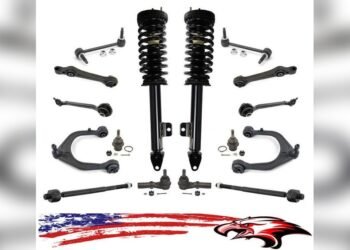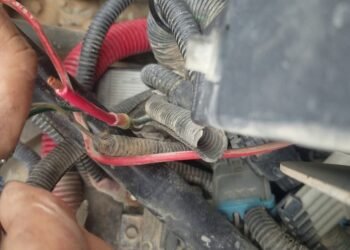The Ford Escape is a popular SUV choice for many drivers. It offers comfort and reliability.
But like any vehicle, it has its issues. Understanding common Ford Escape problems can save you time and money. Whether you own one or plan to buy, knowing potential issues helps. This guide will explore the most frequent problems reported by Ford Escape owners.
From engine troubles to electrical glitches, we will cover it all. Let’s dive into what you should watch out for with your Ford Escape.
Introduction To Ford Escape
The Ford Escape is a compact SUV that first hit the roads in 2000. It has since become a popular choice for many drivers. Known for its versatility, the Ford Escape offers a mix of comfort, technology, and performance. This vehicle has evolved through the years, improving with each new model.
Brief History
The Ford Escape debuted in 2000 as a 2001 model. It was a collaboration between Ford and Mazda. The first generation was well-received for its car-like handling and spacious interior. In 2008, the second generation brought more refined looks and improved features. The third generation, launched in 2013, introduced a more modern design and advanced technology. The latest models continue to push the boundaries of innovation.
Popularity And Usage
The Ford Escape is popular among families and solo adventurers alike. Its compact size makes it easy to maneuver in urban settings. Yet, it offers ample cargo space for trips and adventures. Many appreciate the balance of fuel efficiency and power. The Ford Escape is also known for its reliable performance, making it a trusted choice for daily commuting and weekend getaways.
Transmission Problems
The Ford Escape is a reliable SUV, but it can have some issues. One of the most common is transmission problems. Understanding the symptoms and knowing how to fix them can save you time and money. Here, we will explore the common symptoms, DIY fixes, and professional repair tips.
Common Symptoms
Transmission problems often show certain signs. Here are some common symptoms:
- Strange Noises: Hearing humming, clunking, or whining sounds? Your transmission may need attention.
- Slipping Gears: If your car changes gears unexpectedly, it could be a slipping transmission.
- Delayed Shifting: Experiencing a delay when shifting gears? This is a clear sign of a transmission problem.
- Fluid Leaks: Transmission fluid on your driveway? Your vehicle might have a leak.
- Warning Light: Is the check engine light on? It could be related to the transmission.
Diy Fixes
Some transmission issues can be fixed at home. Here are a few DIY fixes:
- Check Fluid Levels: Low fluid can cause many problems. Ensure your transmission fluid is at the correct level.
- Replace Fluid: Old or dirty fluid can lead to issues. Consider replacing it with fresh fluid.
- Inspect for Leaks: Look under your car for any fluid leaks. Fixing small leaks can prevent bigger problems.
- Reset the Transmission Control Module: Sometimes, a simple reset can fix minor issues. Disconnect the battery for about 30 minutes, then reconnect it.
Professional Repair Tips
If DIY fixes do not work, it is time to consult a professional. Here are some tips:
- Find a Reputable Mechanic: Choose a mechanic with good reviews and experience with Ford Escapes.
- Get a Diagnostic Test: A professional can run a diagnostic test to pinpoint the problem.
- Consider a Transmission Rebuild: Sometimes, a rebuild is more cost-effective than multiple small repairs.
- Ask for a Warranty: Ensure any repair work comes with a warranty. This protects you against future issues.
Addressing transmission problems quickly can prevent further damage. Regular maintenance and timely repairs will keep your Ford Escape running smoothly for years to come.
Engine Stalling Issues
Experiencing engine stalling while driving your Ford Escape can be frustrating and dangerous. This problem can happen for many reasons and needs immediate attention. Understanding why your engine stalls and knowing how to prevent and fix it can save you time and money.
Causes Of Engine Stalling
Several factors can cause your Ford Escape’s engine to stall. Some common reasons include:
- Fuel System Problems: Clogged fuel injectors or a faulty fuel pump can disrupt fuel flow.
- Ignition System Issues: A bad spark plug or ignition coil can cause misfires.
- Air Intake Problems: Dirty air filters or a malfunctioning mass airflow sensor can affect performance.
- Electrical Issues: Problems with the battery, alternator, or wiring can lead to stalling.
Preventive Measures
Taking care of your car can prevent engine stalling. Here are some tips:
- Regular Maintenance: Follow your vehicle’s maintenance schedule for oil changes, filter replacements, and check-ups.
- Clean Air Filters: Replace dirty air filters to ensure proper airflow.
- Check Fuel System: Use high-quality fuel and clean fuel injectors regularly.
- Inspect Electrical Components: Check the battery and alternator for signs of wear.
- Monitor Warning Lights: Pay attention to dashboard warning lights and address issues promptly.
Repair Solutions
If your Ford Escape is already stalling, consider these repair solutions:
- Replace Spark Plugs: New spark plugs can improve ignition and reduce stalling.
- Clean Fuel Injectors: Professional cleaning can restore proper fuel flow.
- Fix Electrical Issues: Repair or replace faulty wiring, battery, or alternator.
- Replace Air Filters: New air filters can improve engine performance.
- Update Software: Ensure your vehicle’s software is up-to-date for optimal performance.
By understanding the causes, preventive measures, and repair solutions for engine stalling, you can keep your Ford Escape running smoothly. Regular maintenance and quick fixes can go a long way in preventing issues.

Credit: www.youtube.com
Electrical System Failures
Electrical System Failures in the Ford Escape can be frustrating and dangerous. These issues can cause the vehicle to malfunction or not start. Understanding these problems helps you take timely action.
Identifying Electrical Problems
Electrical issues in your Ford Escape often show certain symptoms. These can include:
- Dim or flickering lights
- Dead battery
- Unresponsive dashboard
- Non-functioning power windows
If you notice these signs, your car likely has electrical problems.
Simple Fixes
Some electrical issues have simple fixes. Here are a few:
- Check the battery: Ensure the battery is charged and the terminals are clean.
- Inspect fuses: Look for blown fuses and replace them.
- Examine the wiring: Check for loose or damaged wires.
These steps can solve minor electrical problems quickly.
When To Consult A Technician
Some issues need professional help. Consult a technician if:
- Simple fixes do not work
- Electrical problems keep coming back
- You hear strange noises from the dashboard
A trained technician will diagnose and fix complex electrical problems.
Brake System Concerns
Brake System Concerns are among the most critical Ford Escape problems. Poor brakes can lead to dangerous situations. Addressing brake issues quickly ensures your safety on the road.
Signs Of Brake Problems
Recognizing the signs of brake problems early can prevent severe damage. Look out for the following indicators:
- Grinding or squeaking noises when braking
- Vibrations in the brake pedal
- Longer stopping distances
- Brake warning light on the dashboard
These signs often point to worn-out brake pads, warped rotors, or low brake fluid.
Routine Maintenance
Regular maintenance is key to keeping your Ford Escape’s brake system in top shape. Here are essential tasks:
| Task | Frequency |
|---|---|
| Brake pad inspection | Every 12,000 miles |
| Brake fluid check | Every 24,000 miles |
| Brake line inspection | Every 24,000 miles |
Follow these guidelines to ensure your brakes are always ready for action.
Advanced Repair Methods
Sometimes, routine maintenance is not enough. Advanced repair methods might be necessary:
- Brake pad replacement: Essential if pads are worn out.
- Rotor resurfacing or replacement: Fixes warped or damaged rotors.
- Brake fluid flush: Removes old, contaminated fluid.
- Brake line replacement: Necessary if lines are leaking or damaged.
These repairs should be carried out by professionals to ensure safety and efficiency.

Credit: www.hansmaautomotive.com
Steering Difficulties
Steering difficulties in the Ford Escape can be a significant concern for drivers. These issues can range from slight annoyances to major safety hazards. Understanding common problems and their solutions is key to ensuring a safe driving experience.
Common Steering Issues
Ford Escape owners often report issues with the power steering. This can include the steering wheel feeling stiff or difficult to turn. Another common problem is a clunking noise while steering. This noise can indicate a worn-out steering component. Misalignment is also a frequent issue. It can cause the vehicle to pull to one side.
Quick Fixes
Check the power steering fluid level. Low fluid can cause stiffness. Topping it up can solve the problem. Inspect for loose or damaged belts. Replacing them can improve steering. For noise issues, lubricate the steering column. This can help reduce or eliminate the clunking sound. If the vehicle pulls, check the tire pressure. Uneven pressure can cause misalignment.
Long-term Solutions
Regular maintenance is crucial. Schedule routine check-ups to catch issues early. Consider replacing worn-out steering components. This includes tie rods and ball joints. Use quality parts for replacements. Proper alignment is essential. Get the wheels aligned regularly. This prevents uneven tire wear and improves handling.
Air Conditioning Troubles
Air conditioning troubles can turn a pleasant drive into a sweaty ordeal. The Ford Escape, known for its reliability, is not immune to these issues. Identifying and fixing AC problems can be straightforward with the right guidance. Let’s dive into diagnosing AC problems, basic repairs, and professional services.
Diagnosing Ac Problems
First, check if the air conditioning is blowing warm air. This could indicate a refrigerant leak or a faulty compressor. Listen for unusual noises when the AC is running. Strange sounds could signal a broken component. Use a thermometer to measure the air temperature coming from the vents. If it’s not cold, there’s a problem.
- Check refrigerant levels.
- Inspect the compressor.
- Listen for unusual noises.
- Measure air temperature.
Basic Repairs
Some AC issues can be fixed easily. Start by replacing the cabin air filter. A clogged filter can reduce airflow. Check for any visible leaks in the system. Use an AC recharge kit to refill refrigerant levels. Make sure to follow the instructions carefully.
- Replace the cabin air filter.
- Look for visible leaks.
- Refill refrigerant with an AC recharge kit.
Professional Services
If basic repairs don’t work, it’s time to seek professional help. Technicians can perform a thorough inspection and identify hidden issues. They have the tools to fix complex problems. Here’s a comparison of common services and costs:
| Service | Estimated Cost |
|---|---|
| Compressor Replacement | $500 – $700 |
| Refrigerant Recharge | $100 – $150 |
| Leak Repair | $150 – $300 |
Make sure to get a detailed quote before any repairs. This can help you budget and avoid unexpected costs. Reliable AC service ensures a comfortable drive in your Ford Escape.

Credit: www.youtube.com
Suspension And Handling
The suspension and handling of your Ford Escape are crucial for a smooth ride. Problems in these areas can lead to discomfort and safety concerns. Understanding the symptoms, maintenance tips, and repair options can help you keep your vehicle in top shape.
Symptoms Of Suspension Issues
Recognizing suspension problems early can save you from bigger issues later. Here are some common symptoms:
- Uneven tire wear
- Rough or bouncy ride
- Drifting or pulling during turns
- Nose dives when braking
- Excessive vibration while driving
If you notice any of these signs, it’s time to take action.
Maintenance Tips
Regular maintenance can prevent many suspension issues. Here are some tips:
- Check tire pressure monthly.
- Inspect shocks and struts every 50,000 miles.
- Look for leaks or damage in the suspension system.
- Listen for unusual noises while driving.
- Get an alignment check yearly.
Following these steps can keep your suspension in good condition.
Repair Options
If you need repairs, you have several options:
| Issue | Repair Needed |
|---|---|
| Worn shocks/struts | Replace shocks/struts |
| Leaking fluid | Fix or replace damaged parts |
| Broken springs | Replace springs |
| Misaligned wheels | Alignment service |
Choosing the right repair can improve your Ford Escape’s handling and safety.
Frequently Asked Questions
What Are Common Ford Escape Transmission Problems?
Ford Escape often experiences transmission slipping, hard shifts, and delayed engagement. Regular maintenance helps prevent these issues.
Why Does My Ford Escape Engine Overheat?
Engine overheating can be due to coolant leaks, faulty thermostats, or radiator problems. Checking and fixing these parts can help.
How Do I Fix Ford Escape Battery Drainage?
Battery drainage can result from faulty alternators or electrical issues. Inspecting these components can resolve the problem.
What Causes Ford Escape Brake Issues?
Brake problems may stem from worn brake pads, caliper issues, or brake fluid leaks. Regular checks ensure brake safety.
Are There Ford Escape Electrical System Problems?
Yes, common issues include malfunctioning sensors, wiring problems, and faulty alternators. Regular diagnostics can identify these issues.
Conclusion
Owning a Ford Escape comes with some common issues. Regular maintenance can help. Always stay proactive with vehicle care. Address problems early to avoid bigger issues. Consult a trusted mechanic for any concerns. Remember, keeping your Ford Escape in good shape ensures a smoother ride.
Stay informed about potential problems to drive with confidence. Happy driving!
















